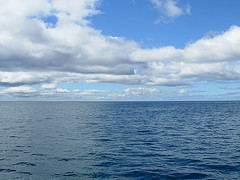Aperture Mode or Aperture Priority
 In Aperture Priority mode you get to select the aperture (f/stop) and your camera automatically selects the shutter speed to give you the best exposure. Now, best exposure may not be a good exposure for what you want, it is just the best your camera can offer within it programming constraints and available options. You should always look at your photo and adjust accordance if what you are getting is not what you want.
In Aperture Priority mode you get to select the aperture (f/stop) and your camera automatically selects the shutter speed to give you the best exposure. Now, best exposure may not be a good exposure for what you want, it is just the best your camera can offer within it programming constraints and available options. You should always look at your photo and adjust accordance if what you are getting is not what you want.  For most cameras you will have some kind of dial to rotate or slide to adjust the aperture. A small aperture will give you high F/stop numbers and a large or open aperture will give you low F/stop numbers.
For most cameras you will have some kind of dial to rotate or slide to adjust the aperture. A small aperture will give you high F/stop numbers and a large or open aperture will give you low F/stop numbers.Think of the aperture as the pupil of your eye and the F number like the cornea in your eye. (For those who don't know, the pupil is the black portion of your eye and the cornea is the color portion of your eye - green, blue, brown, etc) If it is bright outside, your pupil/aperture gets small to let less light in and the cornea/F number gets larger to take the space of the pupil.
As you probably guessed from reading my example above, the aperture controls how much light reaches your cameras sensor. This is why the aperture is an integral part of the exposure. When you combine the shutter speed with the aperture you are setting the exposure for your photo. If you increase the aperture (use a small F/number) you are allowing more light through to your camera's sensor. To not get an overexposed photo, your camera under aperture priority mode will increase the shutter speed to make up for the extra amount of light.
As with shutter speed don't forget about your ISO setting- this can be used to increase the amount of f/stops you can use and still get a good photo. If there isn't much light but you want to have a deep DOF you will have to use a small aperture which may make your photo underexposed. To fix this you could increase your ISO which will add a gain to the camera's sensor giving you more lightly in your photo. Don't go crazy ISO also adds noise to your photos, so use it accordingly.
Last modified: Thursday, July 22, 2010, 12:44 PM